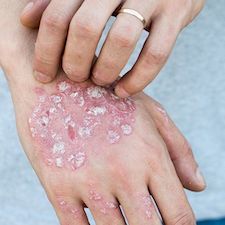Article
Considerable Global Prevalence of Metabolic Syndrome in Patients with Psoriasis
Author(s):
Though previous research had demonstrated an increased risk of MetS in patients with psoriasis, this study was first to consider the prevalence of the condition a global scale.

Investigators from China suggested a greater focus toward identifying and managing metabolic disorders in patients with psoriasis after a new meta-analysis found that patients affected by the skin disease were at an increased risk of metabolic syndrome (MetS).
Previous research had demonstrated an increased risk of MetS in patients with psoriasis, yet this study was the first to consider the prevalence of the condition a global scale.
While the prevalence varied depending on the region and psoriasis types and severities, the study determined that MetS was prevalent in 32% of adults and 9% of children and adolescents with psoriasis.
Psoriasis is believed to affect 2-3% of the general population. As such, an investigative team led by Liu Liu, PhD, Department of Dermatology at Yeuyang Hospital of Integrated Traditional Chinese and Western Medicine in Shanghai, sought to analyze the prevalence of MetS among adult and adolescent patients.
The Methods
The study featured an extensive systematic review of available literature that utilized a combination of key words including psoriasis, metabolic syndrome, incidence, prevalence, and epidemiology.
Eligible studies were required to feature original research, be observational with a defined study type that included case-control, cross-sectional, cohort, and HUNT, have full available text, source population of patients with psoriasis, the number or percentage of MetS cases, and meet specific diagnostic criteria.
Of the articles that were retrieved for the study, a majority were excluded due to incomplete data or diagnostic criteria lacking or being unclear.
Investigators collected data on eligible studies which included diagnostic criteria for psoriasis and MetS as well as the number of cases of psoriasis, prevalence of comorbidities, and MetS diagnosis. Additionally, 2 quality assessment tools were used to evaluate the risk of bias and the quality of case-control and cohort studies.
The Findings
Ultimately, 45 studies were included in the analysis. As previously mentioned, investigators found that the global prevalence of MetS was 32% and 9% globally among adults and children and adolescents, respectively.
Notably, Latin America had the highest prevalence of MetS at 47%, while North America had the lowest prevalence at 26%.
Regarding psoriasis type and severity, those with psoriasis vulgaris (29%) or severe psoriasis (37%) had higher prevalence of MetS than any other psoriasis types included in the study.
Metabolic syndrome diagnostic criteria did appear to influence prevalence findings, with studies using NCEP-ATP III criteria indicating the highest (55%) and studies using IDF indicating the lowest (15%).
Ultimately, investigators believed the study provided significant evidence of increased risk of MetS in patients with psoriasis.
“Our findings suggest the need to identify and manage metabolic disorders in patients with psoriasis,” the team wrote. “Future studies should evaluate the pathogenesis of MetS in this patient population.”
The study, "Global prevalence of metabolic syndrome in patients with psoriasis in the past two decades: current evidence," was published online in JEADV.




